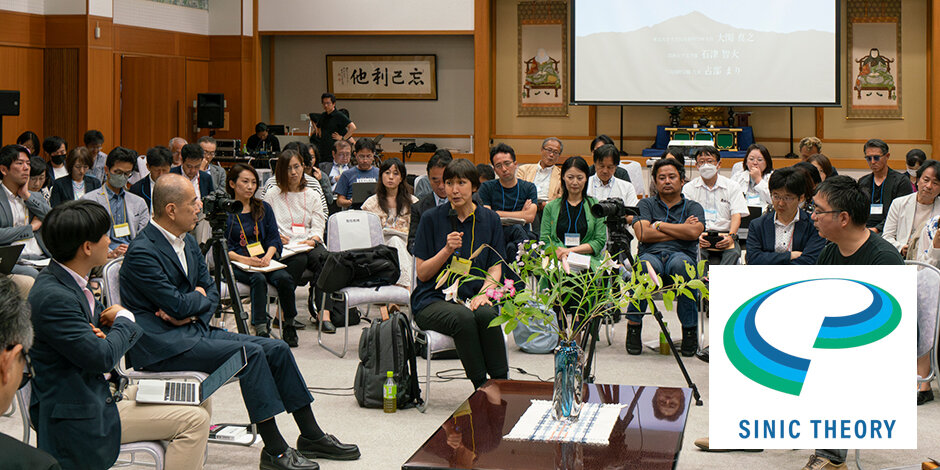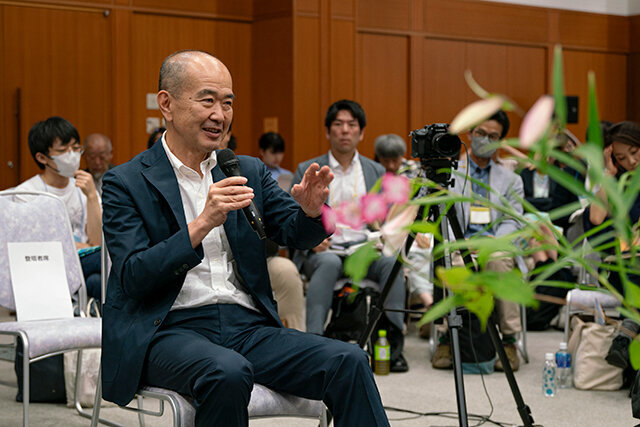
In our contemporary era of rapid change and uncertain outlook, shedding light on the nature of future society is an important part of contemplating our way of life and livelihood. Have you ever stopped to think about what life will be like for you and your society 2-3 years from now and in the future beyond that in a medium and long-term perspective?
OMRON's founder Kazuma Tateishi embarked on futurology research in the belief that predicting the future would be essential in order to build a better society. In 1970, he presented his "SINIC theory " at the International Future Research Conference. This theory, which envisioned science, technology, and society mutually impacting each other as they advance, has accurately predicted subsequent developments such as the "information society" and "optimization society."
ŌåÆRead more about SINIC theory
https://www.omron.com/jp/ja/about/corporate/vision/sinic/theory.html
So, what kind of future is coming next? The SINIC theory predicts that around 2025, we will see the advent of an Autonomous Society focused on values of the "mind." The Human Renaissance Institute (HRI), an OMRON group company and future research think-tank, is pursuing research to forecast what kind of society this will actually be. This research has identified three key components of the autonomous society: independence (to stand on one's own), collaboration (to connect with one another), and creation (to produce new things). Where independence and collaboration come together, "coexistence" emerges; where independence coincides with creation, "individuality" is born; in the space between collaboration and creation, there is "co-creation." And where all three elements overlap, there is "future potential," or the "conviviality." This is the pathway toward a society of independence and coexistence, where people create things while sharing their enjoyment with others.
Across society, there is a growing interest in elements of spiritual civilization such as feeling, sensibility, and emotion. We are moving away from an administered society and toward one where each and every member can experience the joy of living: a society in which problems such as social isolation and economic disparity are resolved and people can apply themselves toward self-realization while co-existing with others. Such a society might be just around the corner now.
Looking ahead to this future society also raises the question of how to design science and technology to satisfy new social needs. Important here will be the establishment of a new field of psycho-biological technology pertaining more to humans' inner world, spirituality, and emotions, exercising an ethical influence on technology. In 2025, the desirable state might be to have "individuals and society," "humans and machines" and "humans and nature" existing in optimal balance.
ŃĆĆ
Building on the findings from many years of research, and with the end of the predicted future almost in sight, the Human Renaissance Institute updated the SINIC Theory in 2022. There were three key points to this update:
ŃĆĆ
In order to achieve a higher-resolution view of the imminent Autonomous Society and to further refine the SINIC theory in light of the 2022 update, the Human Renaissance Institute hosted the inaugural Hieizan Future Conference on June 29, 2023. The conference was held at the Enryakyuji Temple in Hieizan (Mount Hiei, mountain to the northeast of Kyoto). The ancient Buddhist monk Saich┼Ź who founded the temple, once said that if each and every person can shine and join hands in a "circle," a wonderful world will be created. 187 thought leaders and practitioners in future creation in the fields of science, technology, and society came together at the conference to engage in lively discussion toward building a better future. Feedback from the participants included statements such as: "we had different views depending on our specializations, and I appreciated the opportunity to understand ways of looking at things that were different from my own"; "I realized that in order to think about the future, it is essential to reflect on the past and contemplate the nature of humanity itself"; "the conference prompted me to think seriously and take action based on a vision for society going forward."
 Left: Communication between participants Right: Explanation of SINIC theory
Left: Communication between participants Right: Explanation of SINIC theoryŃĆĆ
| Outline | Speakers |
| Introduction | Yuya Nishimura, Executive Director, MIRATUKU |
| Ikebana Performance | Senkei Kuwahara, 15th Master of the Kuwahara Senkei School |
| Opening Address | Kiichiro Miyata, CTO, Representative Director, and Executive Vice President, OMRON Corporation |
| Check-in | Yuya Nishimura, Executive Director, MIRATUKU |
| Keynote Lecture The Empathy Revolution and Post-Pandemic Future |
Juichi Yamagiwa, Research Institute for Humanity and Nature |
| Organizer Lecture SINIC, Looking at Autonomous Society with Better Resolution |
Shinichi Nakama, Executive Fellow, Human Renaissance Institute |
| Session A Foundations for Autonomy and their Application to Future Society |
Masayuki Ohzeki, Professor, Tohoku University Graduate School of Information Sciences Tomohiro Ishizu, Professor, Kansai University Faculty of Letters Mari Urabe, President, Uzawa Kokusai Gakkan (facilitator: Shinichi Nakama and Yuya Nishimura) |
| Session B Bodies, Life, Knowledge, and the Future |
Seiji Kumagai, Associate Professor, Kyoto University Institute for the Future of Human Society Takeshi Naganuma, Professor, Hiroshima University Graduate School of Integrated Sciences for Life Yuki Inoue, Co-Founder, INNO LAB International ( facilitator: Shinichi Nakama and Yuya Nishimura) |
| Closing Remarks | Ikuo Tateishi, President, Human Renaissance Institute |
ŃĆĆ
Watch a video digest of the Hieizan Future Conference here
ŃĆĆ
Below is an article titled "SINIC Theory and the Hieizan Future Conference" that appeared in the Dempa Digital news service on June 21.
"Let's talk about building a better future." The Hieizan Future Conference 2023 was hosted at Enryakuji Temple in Hieizan in June by the Human Renaissance Institute, OMRON's futurology research arm. The conference brought together 187 scholars, practitioners of future creation, and young people. A circular seating layout was used, with the audience surrounding the presenters.
The conference focused on the SINIC theory, a future prediction method first presented in 1970 by OMRON's founder Kazuma Tateishi. This theory hypothesizes the advent of an Autonomous Society (2025-32) and a Nature Society (2033 onward). Informed by expertise in their respective fields of science, technology, and society, conference participants engaged in animated discussion of how to bring these two future societies into sharper resolution, and how to make them a reality.
According to the SINIC theory, we have passed through the Information Society (1974-2004) characterized by advancements in the automation of information processing, and are currently in the Optimization Society (2005-2024), a period of paradigm shift marking the transition from Industrialized Society to Autonomous Society. The theory predicts that people's values and behaviors will change in this society, with the outcomes of information processing utilized for optimization. Next will come the Autonomous Society in which independence, collaboration, and creation will combine in a mind-centered, group-centered values that are the polar opposite of the materialistic, individualistic values of the industrialized society. This society is expected to continue to the Natural Society, in which people, technology, and nature interact productively.
It is now more than half a century since Kazuma Tateishi realized the potential importance of future forecasting in business management and drew up the SINIC theory that postulates social development through interaction of science, technology, and society. Far from fading over time, the theory continues to attract empathy and interest today: a credit to the power of Tateishi's ideas and insight. Those who participated voluntarily in the Future Conference expressed their respect for OMRON's decision not to keep SINIC theory in-house but to make it open-source to enable collaborative creation of a better future. The next Future Conference will be awaited eagerly.
ŃĆĆ
Guided by its mission "to improve lives and contribute to a better society," OMRON is tackling a variety of social issues with a view to improving society. The Hieizan Future Conference was held as part of OMRON's activities to bring the near future into higher resolution and build a better society. Shinichi Nakama, an Executive Fellow with the conference's organizer the Human Renaissance Institute, shared the following thoughts after the conference. "Interest in the future has been growing at an astounding rate in recent years. Notably, the popularization of activities such as remote work during the COVID-19 pandemic has rapidly added a sense of reality to the vision of an Autonomous Society, which at one point people doubted would ever transpire. I think there is huge significance in the fact that the Hieizan Future Conference was held at such a turning point, and in the multifaceted discussions of the future that the conference enabled. News related to generative AI is circulated on a daily basis at present, but it is important to clarify what we actually hope to achieve by using technology. The conference renewed my awareness that both innovation and human needs, including physical senses, are essential. I see the conference itself as a model for the future, with participants collaborating with one another regardless of their company or organizational affiliations. Holding this conference is not the end goal: I'd like to continue researching hand in hand with other participants on how we can make the future better."
 Shinichi Nakama, an Executive Fellow with the conference's organizer the Human Renaissance Institute
Shinichi Nakama, an Executive Fellow with the conference's organizer the Human Renaissance InstituteWe are committed to continuing our research to predict the near future and sharing the findings thereof, so they serve as a compass not only for OMRON but for every person and company in existence today, as we strive to achieve a better society.